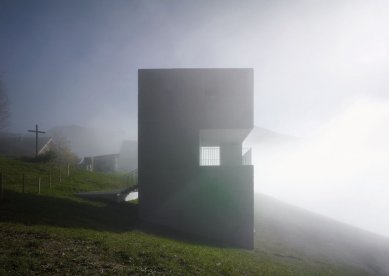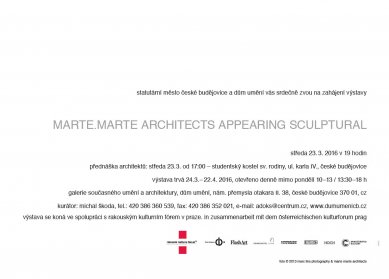
marte.marte architekten - Erscheinend Skulptural
Source
Michal Škoda, Galerie současného umění a architektury
Michal Škoda, Galerie současného umění a architektury
Publisher
Tisková zpráva
23.03.2016 07:20
Tisková zpráva
23.03.2016 07:20
Czech Republic
České Budějovice
Bernhard Marte
Stefan Marte
marte.marte architekten
Venue: Gallery of Contemporary Art, DUČB
Exhibition date: March 24 - April 22, 2016
Lecture: March 23, 2016, at 5:00 PM
Opening: March 23, 2016, at 7:00 PM
Curator: Michal Škoda
Brothers Bernhard /1966/ and Stefan Marte /1967/ studied architecture at the Technical University of Innsbruck. In 1993, they jointly founded the atelier Marte. Marte Architecten in Weiler, a small village in the federal state of Vorarlberg in the Rhine Valley. In addition to a number of private houses, they have also built a significant number of award-winning buildings in the fields of culture, education, infrastructure, and healthcare. Their buildings are characterized by a strict sense of abstraction, reduction, and sensitivity to their placement. Numerous successes in competitions and international awards are evidence of the contribution of this atelier, which currently has a team of 25 employees.
The work of brothers Bernhard and Stefan Marte is typified by the strictness of concept, clear organization, and sculptural form. With great sensitivity, they can respond to the historical context and convincingly reinterpret existing buildings. Besides wood, glass, and compacted earth, concrete is their most frequently used material.
The sculptural expression that Marte. Marte seeks is not merely a question of form, but an expression that offers more than is visible. The idea and content are a clear emotional foundation in their case. They are very sensitive in responding to the context of the environment, and although it may seem from their realizations with a sculptural handwriting that they are reacting to the landscape in which they live and work, it is rather a place in the landscape that becomes a pivotal moment for the architects. They consider it very important, as they state, that within the sculptural language of their forms, they achieve the maximum reduction to the essence itself. However, the reduction itself would lack meaning if the result were not a strong form.
Due to the high quality of their projects, Marte. Marte has received numerous awards and achieved several victories in architectural competitions, which has secured them considerable renown and their name is becoming increasingly prominent on the international stage.
The distinctive handwriting in the form of the shape simplicity of massive buildings that they have managed to develop becomes a mediator for redefining the context of the place and achieving a positive tension in harmony with the order that is evident in the complexity of understanding the given environments, which they very sensitively complement. The frequently used concrete, as the fundamental material for most of their realizations, is not just a favored material but a material that the projects itself require. Concrete, as a freely moldable material, allows for the emergence of sensitively spatial compositions with significant emphasis on the interplay of light and mass.
The exhibition prepared for the Gallery of Contemporary Art and Architecture in České Budějovice is a representative overview of the current work of Marte. Marte Architecten. It is a depiction of concepts, thinking, materials, and also the people behind these projects. The viewer has the opportunity to find themselves in the environment of a unique experience of space, shape, and emotion.
It is a presentation inviting reflection, full of surprises and tension, providing a glimpse into contemporary confrontations with buildings serving artistic and cultural purposes. The exhibition itself stands on the intersection of two planes – one part made up of a white object-space structure and the other part featuring a remarkable series of films created by photographer and experimental filmmaker Andreas Waldschütz.
Part of the exhibition is also a book mapping the previous work of Marte.Marte, which has won the Austrian State Prize for Graphic Design, a silver medal for the most beautiful book in the world in Leipzig, the European Book Prize in Athens, and the DAM Architectural Book Award.
The exhibition was created in collaboration with the Ministry of Culture of the Czech Republic, the Statutory City of České Budějovice, and the Austrian Cultural Forum in Prague.
More information >
Exhibition date: March 24 - April 22, 2016
Lecture: March 23, 2016, at 5:00 PM
Opening: March 23, 2016, at 7:00 PM
Curator: Michal Škoda
Brothers Bernhard /1966/ and Stefan Marte /1967/ studied architecture at the Technical University of Innsbruck. In 1993, they jointly founded the atelier Marte. Marte Architecten in Weiler, a small village in the federal state of Vorarlberg in the Rhine Valley. In addition to a number of private houses, they have also built a significant number of award-winning buildings in the fields of culture, education, infrastructure, and healthcare. Their buildings are characterized by a strict sense of abstraction, reduction, and sensitivity to their placement. Numerous successes in competitions and international awards are evidence of the contribution of this atelier, which currently has a team of 25 employees.
The work of brothers Bernhard and Stefan Marte is typified by the strictness of concept, clear organization, and sculptural form. With great sensitivity, they can respond to the historical context and convincingly reinterpret existing buildings. Besides wood, glass, and compacted earth, concrete is their most frequently used material.
The sculptural expression that Marte. Marte seeks is not merely a question of form, but an expression that offers more than is visible. The idea and content are a clear emotional foundation in their case. They are very sensitive in responding to the context of the environment, and although it may seem from their realizations with a sculptural handwriting that they are reacting to the landscape in which they live and work, it is rather a place in the landscape that becomes a pivotal moment for the architects. They consider it very important, as they state, that within the sculptural language of their forms, they achieve the maximum reduction to the essence itself. However, the reduction itself would lack meaning if the result were not a strong form.
Due to the high quality of their projects, Marte. Marte has received numerous awards and achieved several victories in architectural competitions, which has secured them considerable renown and their name is becoming increasingly prominent on the international stage.
The distinctive handwriting in the form of the shape simplicity of massive buildings that they have managed to develop becomes a mediator for redefining the context of the place and achieving a positive tension in harmony with the order that is evident in the complexity of understanding the given environments, which they very sensitively complement. The frequently used concrete, as the fundamental material for most of their realizations, is not just a favored material but a material that the projects itself require. Concrete, as a freely moldable material, allows for the emergence of sensitively spatial compositions with significant emphasis on the interplay of light and mass.
The exhibition prepared for the Gallery of Contemporary Art and Architecture in České Budějovice is a representative overview of the current work of Marte. Marte Architecten. It is a depiction of concepts, thinking, materials, and also the people behind these projects. The viewer has the opportunity to find themselves in the environment of a unique experience of space, shape, and emotion.
It is a presentation inviting reflection, full of surprises and tension, providing a glimpse into contemporary confrontations with buildings serving artistic and cultural purposes. The exhibition itself stands on the intersection of two planes – one part made up of a white object-space structure and the other part featuring a remarkable series of films created by photographer and experimental filmmaker Andreas Waldschütz.
Part of the exhibition is also a book mapping the previous work of Marte.Marte, which has won the Austrian State Prize for Graphic Design, a silver medal for the most beautiful book in the world in Leipzig, the European Book Prize in Athens, and the DAM Architectural Book Award.
The exhibition was created in collaboration with the Ministry of Culture of the Czech Republic, the Statutory City of České Budějovice, and the Austrian Cultural Forum in Prague.
More information >
The English translation is powered by AI tool. Switch to Czech to view the original text source.


0 comments
add comment











